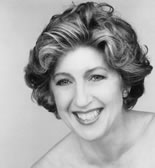
Libby Larsen
Libby Larsen’s Song Cycle “Try Me, Good King” is a group of songs drawn from the final letters and gallows speeches of the first five wives of Henry VIII. Conceived as much as operatic “scenas” as a song cycle, these songs provide the ideal vehicle for American soprano Judith Kellock, Professor of Singing at Cornell University. Kellock and I will performing this cycle at the Baxther Theatre in Cape Town on Monday 3 August 2009, at 13H00.
Other works in the programme include South African composer Peter Louis van Dijk’s “Four American Songs“, Jake Heggie’s “Paper Wings”, and a selection of songs by Samuel Barber as recorded by Judith Kellock on the Koch CD label.

Soprano Judith Kellock
“To me, the human voice is the ultimate instrument. It’s the most reflective, the most personal, the most infinite in its possibilities and the most difficult to write for. (Libby Larsen)” (Duffe)
American composer Libby Larsen (1950) has created a catalogue of over 400 works spanning virtually every genre from songs to 12 operas. Grammy Award winning and widely recorded – including over 50 CD’s of her music, she is one of those rare composers who work by comission only. She seems to be attracted to unusual source material. A quick glance at her list of vocal compositions reveal settings of a fascinating range of texts, with a special interest in women writers: Belle Star (“Cowboy Songs” – 1994), Eleanor Roosevelt (“Eleanor Roosevelt – 1996), Calamity Jane (“Songs from letters” 1989) and evenancient Egyptian hieroglyphics (“I love you through the daytimes” – 2003)
Try Me, Good King
Try Me, Good King is a group of five songs (composwed in 2000) drawn from the final letters and gallows speeches of Katherine Aragon, Anne Boleyn, Jane Seymour, Anne of Cleves, and Katherine Howard. Larsen chose to focus on the intimate crises of the heart that affected Henry’s first five wives. (His last wife outlived him) In a sense, this group of songs is a monodrama of anguish and power.
“Larsen meets the challenge of musically conveying a sense of these five individual women by utilizing an array of musical devices with which she draws distinct, multileveled representations. Most prominent is Larsen’s weaving of selected Elizabethan lute songs into the musical texture of each song, thus creating a foil between the sung and unsung words, a layer that serves both as musical connective tissue as well as offering thought provoking intertextuality. Each queen is given her own song, a musical embodiment of an individual heroine speaking directly to the audience, with the role of narrator or commentator assumed by the lute songs subsumed in each piece. The entire cycle is further linked with the prominent ringing of bells in each song in addition to recurring motivic and intervallic gestures.” (Eileen Strempel)
“Larsen’s signature characteristic in solo vocal music—a great proportion of which sets writings by American women authors—is a continuous, repetitive, perpetual motion figure in the accompaniment. This ostinato is comprised of a melodic figure, a harmonic sequence, a rhythmic pattern, or combinations of these elements. This is a useful device, especially when setting poetry that speaks of events that are in continuous motion, such as the wind waving grain or grass, river water flowing slowly, and moving railroad cars. She describes her compositional style as “built around tonal areas that are vaguely modal and reinforced through pedal tones in the bass. The key to my music is to hear tones that aren’t articulated and to be able to listen to low tones” (Kelton)
“Unquiet Heart”: a recital of American Artsong that includes “Try Me Good King”.
![paper_wings[1] paper_wings[1]](http://acombrink.files.wordpress.com/2009/07/paper_wings1.jpg?w=212)

The Recital by Judith Kellock, so sensatively accompanied by Albert Combrink, at the home of Erik Offermann & Gerda Coetzee, was a feast of delightful controlled and professional musoic making. All of us guests were moved and impressed by the relaxed and amazing “American Songs” a la ‘Paper Wings’. The Libby Larsen ‘Wives’ was a revelation; and the tender intro to his four Amercian Songs by Peter-Louis van Dijk set a deep understanding of his composition. How Judith & Albert got those under their skins so recently is a marvel. We thank them all, and conclude : “What a Joy and Priviledge to meet and hear them, both !” Fr Roy tssf.